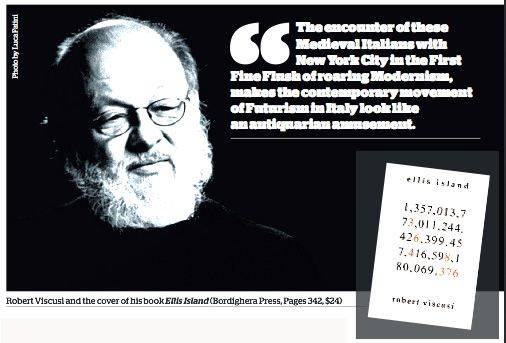Epic Is a Poem Including History
Robert: Well, you know, the adventure, let’s call it that for the moment; the encounter, even better, of these Medieval Italians (which most of them were) with New York City in the First Fine Flush of roaring Modernism, makes the contemporary movement of Futurism in Italy look like an antiquarian amusement. What happened to them when they got here was, I call it an epic confrontation.
You know, Ezra Pound says an epic is a poem including history. Somebody encounters the large movement of things. Here, you have this mass of people completely unprepared for the large movement of things they’re encountering; and the result is as complicated as a world war. And when people talk about Ellis Island, very often they talk about it in this sort of cemeterial way: “I paid a hundred dollars to have my Aunt & Uncle’s names inscribed on the wall.” And there’s nothing wrong with that; I don’t mean to poke fun at the gesture. But it doesn’t close the subject, any more than, let’s say, there’s a fantastic monument to the Marines’ landing at Iwo Jima in Arlington Cemetery. It’s great, it’s moving, it’s spectacular. But, you know, World War II was big, bigger than just this. And the migration too is a big thing. And so that’s what bothered me about the event, when they reopened Ellis Island (and by the way, you know, it’s not open anymore, since the storm last fall), they made it so glossy, they spent more time I think on making sure the gustavino tiles looked really shiny, than they did on almost anything else; and so to me it gave a false kind of plate glass window image of what it’s all about. It’s not just about clothes and cameras and things you can buy and things you can eat.
Anthony: So, let’s go to the book for a couple of references, I’m thinking of pages 4 and 5. We’re only a few poems in and you immediately go into an accented Italian in 1.7.
Robert: “you tella me what thing you wanta me to know.”
Anthony: These four poems are actually on 4 and 5 I found to be nicely tied together just because of what I just said, “It runs the spectrum” and in 1.8 you write:
whatever you start it always ends
up italian
she said that to me because she
loves old fashioned culture
which is to say italian men
That brings up the idea of identity-which we, of course, have discussed a lot. I also like what you do in 1.9:
and the italians brought a green oil
that made the food green
under the misty blur they wore blackhair
and rode black horses into the dreams
of white women
And so your juxtaposing Italiansnon-white to white women. And further still:
they wore white clothes and broke
granite with hammers
so that their very eyelids thickened
with powdered stone
as if michelangelo were conjuring a
frieze of laborers
Robert: My favorite lines in this sonnet.
Anthony: The entire point of origins goes even further back in 1.10, where
they said to us, since you are Italian
learn to sing,
tell jokes, dance and to make
beautiful clothes
unless you are willing to study latin
Whereas Italian wasn’t serious enough.
Robert: That was the issue. You know, I went to Jesuit high school and college. They gave us great scholarships and great curricula, but they would not teach us Italian in high school. Not only would they not teach us Italian, but they did not even want us to bring it up. We were studying Latin. I was so astonished how much it was like Italian, though I didn’t really know Italian. And I said with that kind of innocence, arrogance, that kids can have; I said to the Jesuit, whatever his name was, Mc-something or other, “You know, I’m interested in this because after all these are my people.” He said, “Oh no,” he said, “No. The Romans and the Italians have nothing to do with one another.
Anthony: Ah hah
Robert: I think about it now, it was one of those Arturo Schomburg moments, you know that story when the teacher is telling the history of Puerto Rico, and it’s all white people. And little dark Arturo, just starting school, raises his hand and says, “Where are all the black people?” And the teacher says, “Oh, black people have no history.” That was the foundation of Arturo Schomburg’s collection of materials relating to the history of black people in the Americas, which is now the greatest Library for African American studies.
Anthony: Thank you. We’ll end it here, offering our readers a glimpse at one of the poems in Ellis Island. (see box to the right).


































i-Italy
Facebook
Google+
This work may not be reproduced, in whole or in part, without prior written permission.
Questo lavoro non può essere riprodotto, in tutto o in parte, senza permesso scritto.